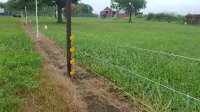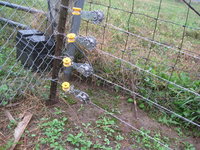Christy:
An electric fence is the solution you are looking for. It is the very best defense you have against your neighbor's dogs.
My neighbors dog wears a muzzle when it is out and about, so has a history of being a bit mean. First day it spotted my birds, it headed straight for them....hit the fence, left with it's tail tucked between its legs and has never been back. About a month ago, I spotted it out in the yard with it's owner........birds were no more than about 50 yards away, running around in the open in full view. Dog was laying on the ground and didn't even look up.
An electric fence is the solution you are looking for. It is the very best defense you have against your neighbor's dogs.
My neighbors dog wears a muzzle when it is out and about, so has a history of being a bit mean. First day it spotted my birds, it headed straight for them....hit the fence, left with it's tail tucked between its legs and has never been back. About a month ago, I spotted it out in the yard with it's owner........birds were no more than about 50 yards away, running around in the open in full view. Dog was laying on the ground and didn't even look up.





